#currently transferring the data from Switch to Switch 2
Explore tagged Tumblr posts
Text
"Proud owner of the Nintendo Switch 2!"

9 notes
·
View notes
Text
Xbox Player Recruitment: Genshin Impact Xbox Series X|S Test Player Recruitment Now Open

Genshin Impact is about to launch on Xbox, and we're launching the "Xbox Test" for Travelers to experience and provide feedback.
Sign up to participate now!
After joining the test server, complete certain testing tasks on the server for a chance to receive a certain amount of Primogems as a reward on the official server.
*Please note that this recruitment is only for Xbox players. Test participants must have an Xbox Series X|S device; otherwise, they will not be able to participate in the test.
How to Apply
Fill out the survey:
>>>Link<<<
Please read the survey carefully and fill it out accurately. If you are eligible for the test, we will notify you via the contact information provided in the survey.
Submission time
September 6, 2024 11:00 (UTC+8) – September 23, 2024 11:00 (UTC+8)
Estimated start time:
Early October
Device Requirements
Currently Supports
Xbox Series S
Xbox Series X
Confidentiality Notice for Test Content
This player recruitment for the test is focused on Xbox content, and most of the content is still in a state of adjustment.
Considering that leaks from the test server could lead to misunderstandings of the official version's content and negatively impact Travelers' experience with the official release, we thus require Travelers participating in the player database to keep the test content completely confidential and not disclose it in any form (including but not limited to screenshots, live streams, videos, etc.).
Therefore, Travelers who have the opportunity to participate in the test will need to sign a confidentiality agreement.
If it is confirmed that a tester has leaked information, they will be dealt with in accordance with the relevant clauses of the confidentiality agreement.
All content on the test server does not represent the quality of the final release. Please refer to the content of the official version for reference.
Notes
1. This test is only for Xbox, and eligibility is tied to the device used for the initial login. Switching to other devices is not allowed. If you change devices and trigger a ban, it will not be lifted. Account sharing or trading is strictly prohibited, and such actions will be considered a breach of the confidentiality agreement.
2. For important information regarding the test recruitment and relevant details, Travelers should rely on official channels such as HoYoLAB. Please refrain from trusting false information from unofficial sources.
3. All Travelers must fill out the information accurately. We will carefully verify the authenticity of the information provided. If there are discrepancies between the submitted information and the actual details, it may result in ineligibility for this test. If errors in the survey are due to personal reasons, we will consider it as a forfeiture of your test eligibility.
4. The test server does not support in-game purchases. After the current test period ends, all data will be deleted. Test eligibility is only valid for the current test and cannot be inherited, transferred, or sold.
5. Please ensure that you are 18 years old or older. Otherwise, you will not be eligible for the test, and we will not enter into a confidentiality agreement with you.
#genshin impact#genshin impact updates#genshin impact news#official#make sure you read all the fine print if you apply#beta testing is fun but the rules are very serious
93 notes
·
View notes
Text
Network switches
What’s a network switch ?
A switch is a device used in computer networks to connect multiple devices together within a single local area network (LAN). Its main role is to facilitate communication between different connected devices, such as computers, printers, servers, IP phones, etc.
It is a mini-computer which is made up of RAM, ROM, flash RAM, NVRAM, a microprocessor, connectivity ports and even an operating system.

RAM
RAM (Random Access Memory) contains the current configuration of the switch and temporarily stores the MAC address table, which is then processed by the microprocessor.
Microprocessor
The microprocessor is the heart of the switch, responsible for data processing, including switching and creating links between multiple devices.
External memories
External memories, such as flash RAM, ROM, and NVRAM (Non-Volatile RAM), store configuration files , different versions of the IOS , etc ...
Ports
The switch ports are the communication interfaces of the switch. There are several of them, generally 24 for a Cisco switch. Each port is associated with an LED which indicates its status and activity.

How does it work ?
Now how does a switch work to transfer information from one machine to another?
Suppose we have 4 machines: A, B, C and D connected to our switch in ports 1, 2, 3 and 4 as follows:
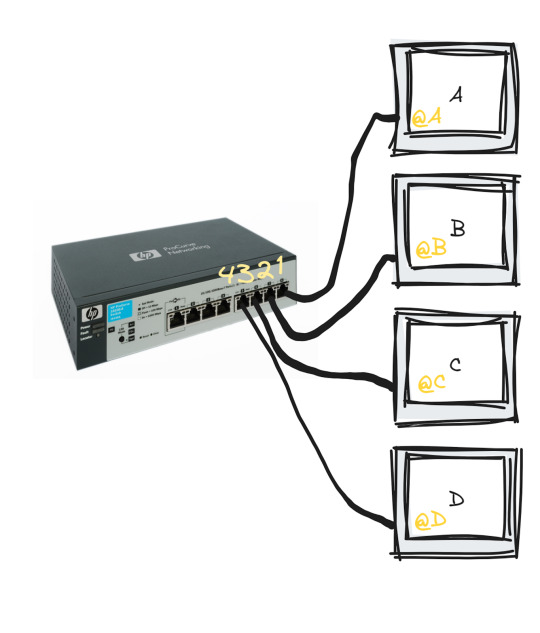
The switch only works with MAC addresses , so basically we have an empty MAC address table stored in RAM as soon as the switch starts up which looks like this :

Transmitting data from machine A to machine B happens in the following steps:
Machine A sends a frame to machine B
Once this frame arrives at port 1 (which is the one linked to A), the switch reads the source MAC address and stores it in the MAC address table
The switch reads the destination MAC address and looks for it in the table, if it is not in the table, it broadcasts to all the active machines connected to the switch except the source one.
If the port linked to the machine we want is active, it sends a response frame from which the switch reads the MAC address we were looking for (@B)
Once done, it records the MAC address of B in the table.

This process repeats until the switch reaches what is called "MAC address table stability", that is to say it knows all the MAC addresses of the connected machines and has no more need to broadcast.
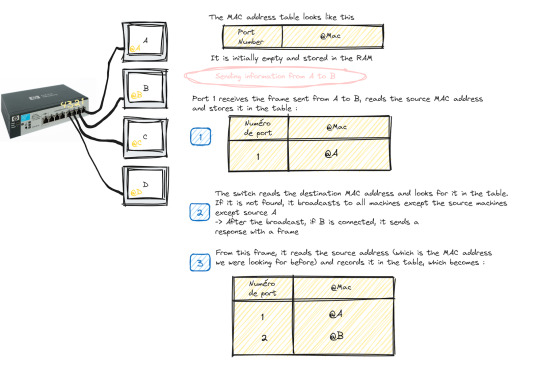
Starting and configuring a switch
When it comes to booting a switch, the process is similar to that of a traditional computer system:
POST (Power-On Self Test): The switch performs proper functioning tests on all hardware.
Loading IOS (Internetwork Operating System): The switch operating system is loaded.
Loading the configuration. At this stage we have two cases:
Either the switch already has a startup configuration defined and stored in NVRAM
Either the switch is blank and it is up to us to define the startup configuration when it goes to setup mode
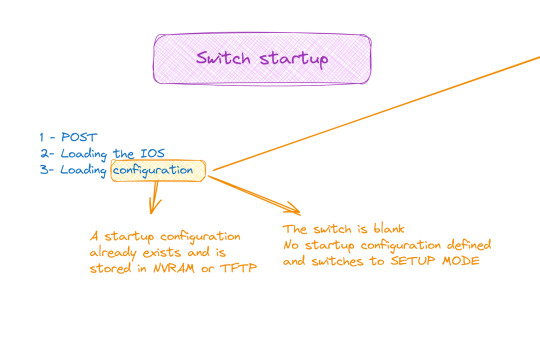
Switch configuration

The configuration of a switch is done through different modes, such as user mode, privileged mode and global configuration mode, which allows access to specific configuration modes, such as interface mode, routing mode, line mode, etc.
And to do all this of course you must first connect the switch with the machine via the console cable and open a terminal emulator
💡 It should be noted that the only machine that can configure the switch is the one connected to it by a console cable, the others are only hosts.
#software#network switches#codeblr#code#css#html#javascript#java development company#python#studyblr#progblr#programming#comp sci#web design#web developers#web development#website design#webdev#website#tech#html css#learn to code
99 notes
·
View notes
Text
How to Migrate a Store from Shopify to Magento?
Migration from Shopify to Magento is a huge leap for your business, offering it more flexibility, scalability, and advanced features. Though this might seem daunting, having a clear roadmap for making this transition will ease the process. The following is a step-by-step guide to help in successfully migrating:
1. Understand Why You’re Migrating
First of all, before one dives in, understand why Magento is a destination point. Yes, Shopify was perfect for simplicity and ease, but Magento means advanced personalization, better scalability, and robust features. If your current platform starts to limit growth, your Magento 2 Migration will be the cool thing to do.
2. Plan and Prepare Your Data
Start by auditing your Shopify store. After auditing is completed, the Shopify merchant may need to make a note of data to migrate, which would involve details related to a product, customers, orders, and the site's content. Clean up your data-remove all outdated and duplicate entries, to keep data from becoming a disaster later on. In that way, everything will go just smoothly when migrated, and the shop could be arranged more organizedly at Magento.
3. Set Up Your Magento Store
Install Magento on a decent hosting platform or take the help of a hosting service dedicated to Magento. After that, configure some basic settings such as tax rules, currencies, and store language. Choose a theme for Magento that will represent your brand identity and customize it for seamless user experience.
4. Export Data from Shopify
Shopify provides an export facility of data into CSV format. In your Shopify admin, go to the export section and download all the required files: products, orders, customer records, etc. Back up your Shopify store to ensure you will not lose any data while migrating.

5. Data Import via Migration Tools
Magento also allows for imports with some tools, which ease the migration of data. You can use extensions for such migrations, like Cart2Cart or LitExtension, which allow automated transfers. This is because the tools will map data fields between Shopify and Magento to reduce human-induced errors.
6. Test Your Magento Store
Perform a full test of your fresh Magento store before going to production. Verify that every piece of data has migrated correctly and all product descriptions, image captions, and customer details are correct. Ensure your payment gateways, shipping methods, and checkouts work flawlessly.
7. Optimize for Performance
Magento offers advanced caching, scalability, and mobile-friendly features. Set these up to enhance the speed of your site and the users' experience. Install SEO extensions to maintain or improve your search rankings post-migration.
8. Launch Your Store
When everything is tested and optimized, switch your domain to Magento. Keep your customers informed about the migration process, emphasizing the benefits of the new platform, whether it be a better shopping experience or exclusive features.
9. Monitor and Improve
After going live, monitor your store's performance and user feedback. Address any issues quickly and continue optimizing your Magento store to align with your business goals.
Migration to Magento can be rather labor-intensive and take a long time, but the payoff in terms of customization, performance, and scalability is there. If you plan properly, this transition will lay a foundation for your business's success in the long run.
For More information, please visit: https://mageleven.com/magento-migration-services
4 notes
·
View notes
Text
Pokémon Stadium Zero
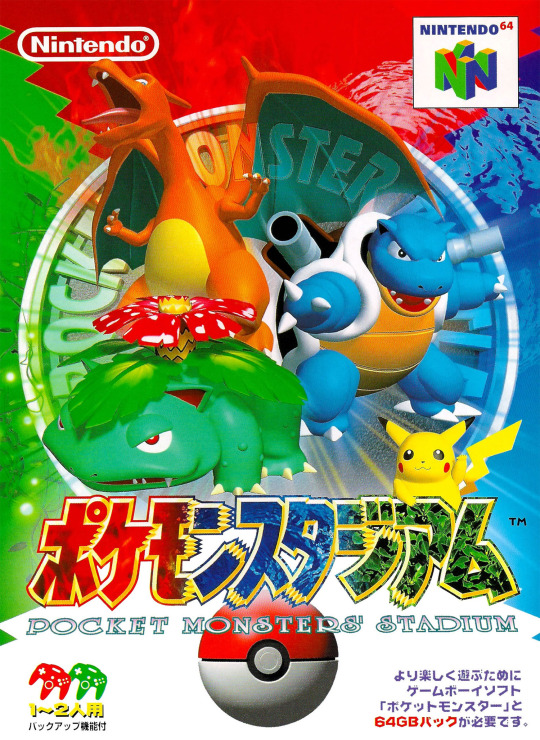
JP release: 1st August 1998
PAL release: N/A
NA release: N/A
Developer: Nintendo
Publisher: Nintendo
Original name: Pocket Monsters Stadium
N64 Magazine Score: 85%

Pokémon Stadium Zero? No, that’s not the official name of the game, but I thought calling it that was the easiest way to differentiate from the Pokémon Stadium the rest of the world knows. The first Pokémon Stadium was exclusive to Japan, so when Pokémon Stadium 2 was localised, it became Pokémon Stadium.

One thing I do need to point out is that emulation is limited. On top of trying to sort out a compatible Japanese save file, emulators currently can’t fully emulate the Transfer Pak – the game can get data from it, but the portion of Pokémon Stadium that lets you play the Game Boy game within the N64 game doesn’t work. This isn’t an issue for the later Pokémon Stadium games, but in Zero, you need to “Report” using an additional menu added by the emulator to fully access the game.
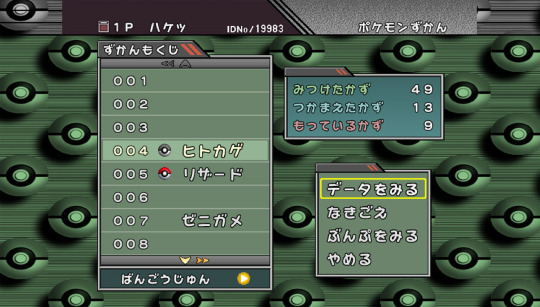
However, without doing this, you can still access the Pokédex, which gives you all of the information and lets you view every single Pokémon in 3D (although, despite this, only 40 available in the battle mode). Other options lets you see lots of statistics on the Pokémon you have in the game, so it’s a great way of seeing your progress.
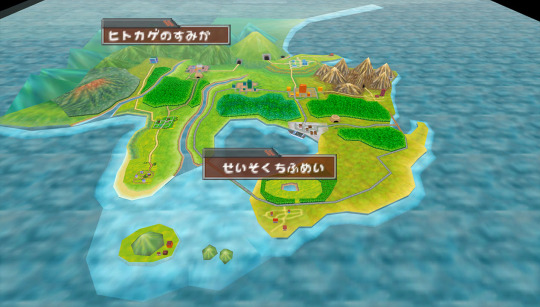
One other nice touch is that you can view where you can find Pokémon on a nice 3D map of Kanto. If you’re struggling to see the locations properly, you can bring up an overlay with the Game Boy map.

In the battle mode – which has free battle and tournament options, you get to choose your Pokémon (out of the 40 in the game) to battle. You can pick from compatible Pokémon in your current Game Boy party (I think you can select others after registering) or loan Pokémon from the game out of all the Pokémon available.

The battling works exactly the same as the Game Boy, although at the start of each fight, you select three Pokémon from your party to take part in that fight. It would have been great seeing your Pokémon not just on the big screen, but in 3D for the first time.
That said, this version of Pokémon Stadium is definitely more cumbersome and a bit more basic than what would later come, so I think the first experience of Pokémon Stadium outside of Japan was definitely better.
The game cultivates an atmosphere of tangible excitement – considering that I’m roughly 20 years older than the intended target audience, yet still felt a shiver of pleasure as my PM trounced the CPU’s pitiful offering, I’d say that Nintendo have quite an achievement on their hands.
- Max Everingham, N64 Magazine #20
Remake or remaster?
A Pokémon Stadium that links to all the various Pokémon games playable on Switch would be a neat idea.
Official ways to get the game.
There is no official way to get Pokémon Stadium Zero
6 notes
·
View notes
Text
Top 10 Projects for BE Electrical Engineering Students
Embarking on a Bachelor of Engineering (BE) in Electrical Engineering opens up a world of innovation and creativity. One of the best ways to apply theoretical knowledge is through practical projects that not only enhance your skills but also boost your resume. Here are the top 10 projects for BE Electrical Engineering students, designed to challenge you and showcase your talents.
1. Smart Home Automation System
Overview: Develop a system that allows users to control home appliances remotely using a smartphone app or voice commands.
Key Components:
Microcontroller (Arduino or Raspberry Pi)
Wi-Fi or Bluetooth module
Sensors (temperature, motion, light)
Learning Outcome: Understand IoT concepts and the integration of hardware and software.
2. Solar Power Generation System
Overview: Create a solar panel system that converts sunlight into electricity, suitable for powering small devices or homes.
Key Components:
Solar panels
Charge controller
Inverter
Battery storage
Learning Outcome: Gain insights into renewable energy sources and energy conversion.
3. Automated Irrigation System
Overview: Design a system that automates the watering of plants based on soil moisture levels.
Key Components:
Soil moisture sensor
Water pump
Microcontroller
Relay module
Learning Outcome: Learn about sensor integration and automation in agriculture.
4. Electric Vehicle Charging Station
Overview: Build a prototype for an electric vehicle (EV) charging station that monitors and controls charging processes.
Key Components:
Power electronics (rectifier, inverter)
Microcontroller
LCD display
Safety features (fuses, circuit breakers)
Learning Outcome: Explore the fundamentals of electric vehicles and charging technologies.
5. Gesture-Controlled Robot
Overview: Develop a robot that can be controlled using hand gestures via sensors or cameras.
Key Components:
Microcontroller (Arduino)
Motors and wheels
Ultrasonic or infrared sensors
Gesture recognition module
Learning Outcome: Understand robotics, programming, and sensor technologies.
6. Power Factor Correction System
Overview: Create a system that improves the power factor in electrical circuits to enhance efficiency.
Key Components:
Capacitors
Microcontroller
Current and voltage sensors
Relay for switching
Learning Outcome: Learn about power quality and its importance in electrical systems.
7. Wireless Power Transmission
Overview: Experiment with transmitting power wirelessly over short distances.
Key Components:
Resonant inductive coupling setup
Power source
Load (LED, small motor)
Learning Outcome: Explore concepts of electromagnetic fields and energy transfer.
8. Voice-Controlled Home Assistant
Overview: Build a home assistant that can respond to voice commands to control devices or provide information.
Key Components:
Microcontroller (Raspberry Pi preferred)
Voice recognition module
Wi-Fi module
Connected devices (lights, speakers)
Learning Outcome: Gain experience in natural language processing and AI integration.
9. Traffic Light Control System Using Microcontroller
Overview: Design a smart traffic light system that optimizes traffic flow based on real-time data.
Key Components:
Microcontroller (Arduino)
LED lights
Sensors (for vehicle detection)
Timer module
Learning Outcome: Understand traffic management systems and embedded programming.
10. Data Acquisition System
Overview: Develop a system that collects and analyzes data from various sensors (temperature, humidity, etc.).
Key Components:
Microcontroller (Arduino or Raspberry Pi)
Multiple sensors
Data logging software
Display (LCD or web interface)
Learning Outcome: Learn about data collection, processing, and analysis.
Conclusion
Engaging in these projects not only enhances your practical skills but also reinforces your theoretical knowledge. Whether you aim to develop sustainable technologies, innovate in robotics, or contribute to smart cities, these projects can serve as stepping stones in your journey as an electrical engineer. Choose a project that aligns with your interests, and don’t hesitate to seek guidance from your professors and peers. Happy engineering!
5 notes
·
View notes
Text
Switch 2... what exactly?
The Nintendo Switch launched March 3, 2017, and today on its seventh birthday, I can't help but to think about the foundation this console has set. It's magnificent, and there's no finer base to build a new console on. Yes, the Switch sets an extremely high bar for Nintendo's next console, but I believe it will soar to even greater heights. The potential is there!
And until Nintendo chooses to reveal its plans, I can only speculate as a lifelong fan. So, please remember that I have zero insider knowledge and I'm simply running with my personal opinions on how I think Nintendo should navigate this situation.
Without further ado, what does the Switch 2 need in order to be successful?
The key feature that makes the most sense is to be backwards compatible with the original Switch. Easy. Simple. Right?

[As of December 31, 2023 - source]
But what could backwards compatible mean in this climate where physical media is at war with the 'convenience' of digital libraries?
Nintendo could pitch backwards compatibility to us and it could mean any of these scenarios:
Our physical cartridges and memory cards can be easily inserted and work instantly. And save data can be easily accessed and transferred between the original Switch and the Switch 2 consoles via online back ups.
Only physical cartridges can be inserted, memory cards cannot be passed between consoles, and digital only games must be redownloaded from the Nintendo eshop. And save data backed up online can be accessed.
Our entire original Switch libraries must be redownloaded digitally from the eshop.
There's no way of knowing what direction Nintendo will choose. I prefer the ease of #1. I want a smooth transition into the Switch's successor.
Even if save data can't move between consoles digitally through Nintendo's safety net, that's not a huge loss. It could potentially give us more save files for some games... unless the back up trying to juggle both data files for the same account causes file corruption... [That's a thought for another day.]
That aside, there are big concerns I have with the other two scenarios. If memory cards can't simply transfer, then you're looking at an additional financial barrier. You either buy more memory cards, or you sacrifice the cards you have and reformat them for the Switch 2.
Additionally, what about games that have been delisted from the eshop?
What about games from other regions? If you can't use the cartridge, can you redownload it digitally without having to jump through hoops and making new accounts?
This touches on the second key feature the Switch 2 needs to maintain. It has to be region free. Not all games are treated equally, but the Switch breaking free from region barriers was a huge leap in the right direction.
Next, the NSO library has to be available day 1, but I'm concerned how Nintendo will do that. Will our paid plans cover our accounts between consoles, will it transfer to the new console, or will we have to buy an entirely new NSO plan for Switch 2?
And lastly, the eshop needs to be fixed. In its current state, it's slow and difficult to navigate. Nintendo needs to redesign it to be functional.
(A bonus aside, the entire Switch eshop library should be accessible from day 1 on the Switch 2.)
Now, going off of what I've outlined... we still have what's essentially a Nintendo Switch. What will be the hook that will entice people to upgrade to the new console?
Higher frame rates, enhanced graphics, and being able to play more complex AAA games like the ones we've seen on competitor hardware. These points are a given. The Switch 2 has to be able to clear this bar in order to maintain its place in the market and encourage players to upgrade.
Still, we need a Nintendo hook. There's no way of knowing what magic they'll hit us with. The Switch is a near perfect console to me. I love being able to game anywhere and anytime.
So, the Switch 2 gimmick I've been dreaming of would be a 'switch' between Nintendo's past, present, and future. It would be about honoring all players, play styles, and Nintendo games.
I know this vision isn't likely, and Nintendo hasn't been friendly to game preservation and backwards compatibility in recent times. I'm fully aware, but this is my personal dream Switch 2 console. I can't emphasize that enough.
The key component of this hook would be the return of the dual screens. It would function similar to the original DS model that maintained the GBA slot. Players utilized a single screen for those games, and the DS ones utilized both. This would immediately kick open the door to the DS, 3DS, and WiiU libraries. Ideally, the console would come with a DS/3DS cartridge slot built in.
And the part where the hook really digs in... There's a market for playing older games on new hardware, and I want to see Nintendo dip their toes in it. Nintendo used to have unique accessories:






Instead of the Switch having unique joy-cons to pair with the NSO, I would like to see Nintendo offer accessories that would attach to the Switch 2's TV connective base and allow the older physical games to run.
Imagine that. Seriously, let this dream sink in.
Each year, older hardware will begin to fail. It's inevitable, but by allowing new means to access older, legacy content... that would ease the pain. It's not perfect because disks and cartridges are also aging, but it's a step in the right direction.
This would also compliment the NSO really nicely. There are plenty of games due to licensing headaches that will likely never see a rerelease in any form, and this would be a legal, safe way to revisit old favorites.
Now that I've clearly aimed for every star in the night sky, what else could the Switch 2 do?
Themes! It's a dearly missed feature of the 3DS and it's still shocking that it's missing from the Switch. I'm even willing to scale things back and remove the special music that came with each theme. If it's all too much for the system to run, fine, but please let me customize that home screen.
And lastly, I want to see the Badge Arcade return. I miss that rabbit. Free him from the 3DS!
What are your Switch 2 hopes, dreams, and fears?
4 notes
·
View notes
Text
OC that I'm thinking about drawing so I'll just type their entire file here.
Codename: Lagswitch
Name: Delta Spade
Age: Currently Unknown
Appearance: A Blonde Woman with Blue Eyes, Wears a Black shirt and light brown jacket, and Denim Jeans
Ability: Self-Lag
This ability allows the user to create a mirage of themself, and becomes detached from this world temporarily, before reappearing to their desired position in which case the mirage disappears.
During this process the Mirage cannot move, speak, cast abilities, etc. And only faces the direction the user casted their ability.
Sub-Ability: Switch
The user can apply Self-Lag onto opponents, self-lag when used on opponents makes them.... Lag in a game sense in which these symptoms occur:
1. The opponent's mind is faster than the body, making their attacks late although the mind had already decided on the move.
2. The opponent's vision makes it so that everything that moves appears and disappears as if everyone stopped and then was immediately somewhere else.
True State: Lagswitch
Everyone in the user's vicinity will begin to lag with the only person being unaffected is the user, during this state the Mirages of everyone can be attacked and the damage will be transfered to their true body once the ability is turned off.
Backstory: Delta was born in the Underground Society along with her parents Jacob Spade and Chara Spade, she wasn't given much attention being the only child they had that didn't have any abilities from birth, Delta wasn't disheartened by this and became a wizard, except.... She wasn't good at any of it, as her Magic Output was.... Close to non existent, using Magic Shards as a substitute to cast Magic, it was expensive to say the least and she doesn't have that kind of money to do that repeatedly, she then studied Runic Magic as it was the only type of Magic that didn't require the use of mana that comes from your body, although it did work for her greatly, this just made her more jealous of her own sister, who is capable of doing the same things she studied for, tenfold.
At their graduation, Delta was filled with jealousy, but she never hated her sister, in fact she was proud of her but just couldn't accept that she was inferior to her sister, she stormed off the ceremony without claiming her diploma, in which then..... She fell from the world.
[Data following these events are the aftermath of the Event.]
"I woke up from a terrible nightmare, it was a dark space only filled with mirrors, there I saw myself, or... My selves....they didn't mock me, belittle me, nor anything alike.... They just stood there, judging me."
"I heard my mother calling to me, it's the time of my graduation..... Wasn't that yesterday?"
"I heard the loud cheers of everyone as they clap for my sister, she wasn't the best.... But she sure as hell was good at almost everything."
"I... I think I fell asleep, it's.... Nighttime? I should get home."
[Data following this event is the aftermath of the Event.]
"I had that same dream again.... I heard those same words... Hours later, the same lines, the same cheers."
[Data following the event is a wonderful one.]
"I could've sworn that I was here and hour ago, was I early? Was I late?...... Why is it repeating?"
[The Data that follows is from the wonderful one.]
"As far as I know it's been years....... I didn't seem to age, nor grow any hair, it's like that one movie that the day keeps repeating over and over......"
[Was there any data to be extracted in the first place?]
"I heard a different noise that time..... It sounds like it's calling me.... Am I dead? Hahaha hahaha, hope not."
[Where were we?]
"This is getting boring.....i figured that I couldn't change the events that occur, and... I don't seem to exist as nobody ever noticed me, no one paid attention, no one looked for me, nothing."
[Oh yeah there it is! I kept looking for that everywhere.]
"I tried looking for everything that might give me a sign, but.... I found none."
"The voices had stopped, everything has stopped, the days no longer repeat, and it is the same endless night I've trapped myself in."
"I went to the circus to find a house of mirrors, in which I lied down and stared at myself for hours."
"How long has it been since I've heard something different?"
"The Mirrors have stopped working."
"I could no longer see myself."
"Maybe it's all just a dream."
"that I will never wake up from."
[Data up to this point was extracted.]
(will delete this after I draw the OC.)
#ocs#oc#character design#original character#short story#original post#I found some sort of glitch in the days that kept repeating it seems as if someone was responsible for it.... I must find it.
5 notes
·
View notes
Text
I'm into Gen 1/2 glitches, and after reviewing the Gold/Silver Decompilation, I think I have a working theory.
For link battles in Gens 1 and 2, the party data gets transferred before the start of the battle and the two games sync their RNG seeds (that's why it has to load for a few seconds). After that, each turn it only exchanges a 4-bit number.
Essentially, it sends over a number between 0 to 15, with 0-3 being the Pokemon's 1st through 4th moves, and 4-9 indicating switching to your 1st through 6th Pokemon. 13-15 are special actions (no action, struggle, and forfeit).
When a Pokemon faints, however, it's assumed that the next action it receives is a switch action. This allows you to switch to party Pokemon #7-#11 and #253-255. Obviously, these don't exist, which means it will send out a Pokemon from unrelated data.
My theory is that some hardware malfunction or glitch caused your Gameboy to enter a loop of sending over some number between 0 and 3. This would cause it to send out a Pokemon whose data comes from the cartridge's ROM.
Doing the math on the hex values and looking it up in the US Gold version ROM data, attempting to send out Pokemon #254 gives us... A Tangela.
It's Level 0 instead of 1 and only knows Wrap and Hydro Pump, but perhaps the details were lost with memory or you played on another version?
As for why it went first, I suspect this is because it just had a wildly high speed stat. A Pokemon's current stats are saved every time they change to avoid needing to recalculate them, so initially they would be unrelated to level and species. Checking the data, it's speed stat would have been 57,423.
After the Tangela faints, it then runs a check to see if every Pokemon in the party is fainted. It would see that your Drowzee is still healthy and thus continue the battle.
Since your Gameboy is stuck sending the same number over and over, it would then tell the other game to send out the exact same Pokemon: a level 0 Tangela.
The reason why it would still be healthy even after fainting is because it comes from the ROM. When switching a Pokemon in, it copies its data from the party slot to a special active slot. Then, when it faints or switches, it copies it back. But because ROM cannot be altered, it would not remember that the Tangela has fainted. Thus, the Tangela is immortal.
Had it continued, they would have fought the exact same Tangela, over and over, until they ran out of PP and Struggled themselves to death. Therefore and thusly I hereby crown you the true winner of that battle. Kinda.
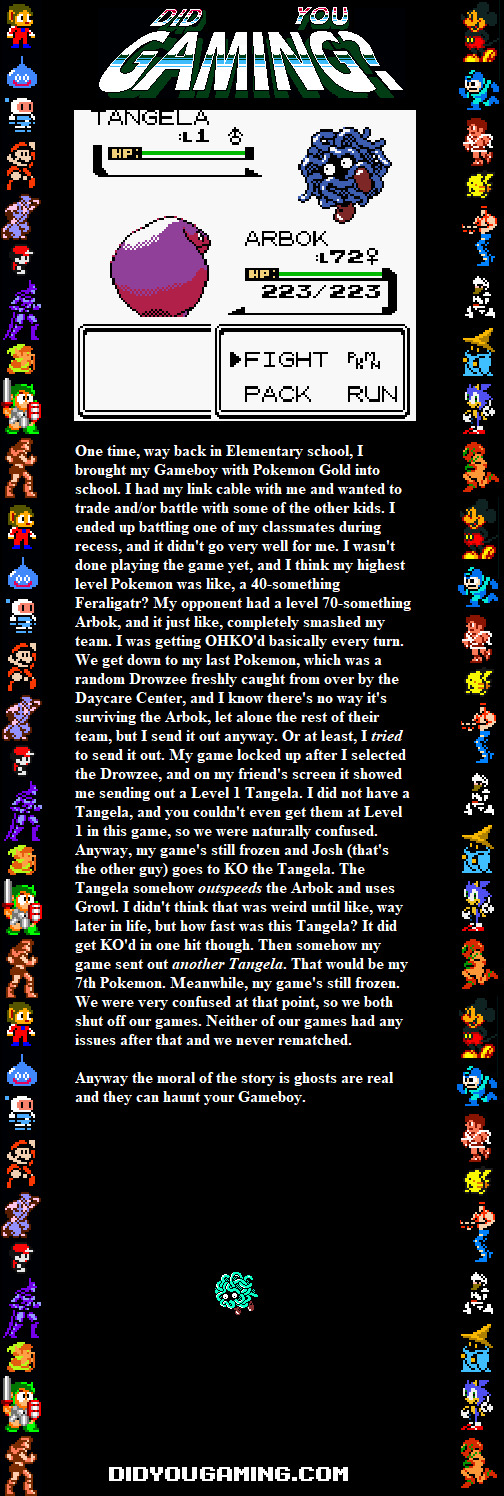
2K notes
·
View notes
Text
Cloud Migration Services: Unlocking the Future of Business Agility
In today's digital-first world, businesses are under increasing pressure to innovate rapidly, reduce operational costs, and remain competitive. Cloud migration services have emerged as a vital enabler of this transformation. By moving applications, data, and workloads from on-premises infrastructure to cloud environments, organizations can harness unprecedented levels of scalability, flexibility, and resilience. But what exactly are cloud migration services, and why are they essential for modern enterprises?
Understanding Cloud Migration Services
Cloud migration refers to the process of transferring digital assets—such as data, applications, and IT processes—from local data centers to cloud platforms like Amazon Web Services (AWS), Microsoft Azure, Google Cloud Platform (GCP), or hybrid cloud environments Cloud migration services encompass the end-to-end support required to execute this transition seamlessly, including strategy development, assessment, architecture design, security planning, data migration, application modernization, and post-migration optimization.
Cloud migration service providers typically offer tailored solutions based on the unique needs of a business. These services can range from simple lift-and-shift migrations to complex transformations that involve rearchitecting applications for the cloud.
Why Businesses Are Migrating to the Cloud
1. Cost Efficiency
Traditional on-premises infrastructure requires significant capital investment in hardware, maintenance, and IT staff. Cloud platforms operate on a pay-as-you-go model, allowing businesses to convert capital expenses into operational expenses. This financial flexibility is especially valuable for startups and SMEs that need to scale without breaking the bank.
2. Scalability and Flexibility
Cloud environments offer dynamic scaling, meaning businesses can adjust their resources based on current needs. Whether experiencing a sudden spike in user demand or planning long-term growth, the cloud provides the flexibility to scale operations without the delays and costs associated with physical infrastructure upgrades.
3. Improved Performance and Accessibility
With data and applications hosted in the cloud, employees can access critical business tools from anywhere in the world. This accessibility boosts productivity, supports remote work, and enhances collaboration across teams and geographies. Cloud services also offer high-performance computing and faster data processing capabilities, improving overall system performance.
4. Enhanced Security and Compliance
Contrary to earlier fears, cloud platforms now offer robust security features that often surpass traditional data centers. Cloud providers invest heavily in security infrastructure, offering features such as encryption, identity and access management (IAM), firewalls, and compliance monitoring. Cloud migration services include comprehensive security planning to ensure data integrity and regulatory compliance.
5. Business Continuity and Disaster Recovery
One of the most compelling reasons for cloud migration is improved business continuity. Cloud platforms offer built-in redundancy, data backups, and disaster recovery solutions that minimize downtime and data loss during unexpected events. This resilience is crucial for maintaining customer trust and operational continuity.
Types of Cloud Migration Strategies
Migration to the cloud is not a one-size-fits-all solution. Different strategies are employed depending on an organization’s needs:
Rehosting (Lift-and-Shift): Moving applications without making significant changes.
Replatforming: Making minimal changes to optimize for the cloud environment.
Refactoring: Rewriting applications to fully leverage cloud-native features.
Repurchasing: Switching to a cloud-based version of an application (e.g., moving from a self-hosted CRM to Salesforce).
Retiring and Retaining: Phasing out obsolete systems or retaining some workloads on-premises for strategic reasons.
A professional cloud migration service provider will assess the existing IT landscape and recommend the most suitable approach.
Challenges in Cloud Migration
Despite its benefits, cloud migration is not without challenges. Poor planning, lack of expertise, data security concerns, and application compatibility issues can derail migration efforts. Additionally, downtime during migration can disrupt operations if not properly managed.
To mitigate these risks, businesses should partner with experienced cloud migration service providers who follow best practices, including thorough assessments, pilot testing, and phased rollouts. Proper change management and staff training are also crucial for successful adoption.
The Role of Cloud Migration Service Providers
Cloud migration service providers play a pivotal role in ensuring a smooth transition. Their responsibilities include:
Assessment and Planning: Evaluating current infrastructure, identifying dependencies, and creating a migration roadmap.
Cloud Architecture Design: Building scalable and secure cloud environments tailored to the organization’s needs.
Migration Execution: Managing the actual transfer of data, applications, and processes with minimal disruption.
Testing and Validation: Ensuring all systems function correctly in the new environment.
Optimization and Support: Providing ongoing monitoring, performance tuning, and cost optimization post-migration.
By leveraging the expertise of migration specialists, businesses can avoid costly mistakes and accelerate their digital transformation journey.
Looking Ahead: The Future of Cloud Migration
As technologies such as artificial intelligence, machine learning, IoT, and big data analytics continue to evolve, the demand for agile, scalable cloud infrastructure will only grow. Cloud migration is no longer a luxury—it is a strategic imperative for businesses seeking to remain relevant in a digital economy.
Future trends in cloud migration services include automation-driven migrations, AI-powered workload analysis, and increased adoption of hybrid and multi-cloud strategies. These innovations will make cloud adoption faster, smarter, and more cost-effective.
Conclusion
Cloud migration services are more than just a technical shift—they represent a strategic investment in the future of business. By embracing the cloud, organizations unlock new levels of agility, innovation, and resilience. With the right partners and a clear roadmap Cloud migration services becomes a powerful catalyst for digital transformation and long-term success.
1 note
·
View note
Text
The Six Levels of Artificial Intelligence: From the Reactive Machine to the Super-intelligent Mind
We speak as if Artificial Intelligence is a single entity. A single revolution, but what if the line is not straight? What if it’s a staircase and we climb it with our eyes closed?
AI is not only evolving, but rather, it’s climbing. And with each step, it is less tool and more entity. From the mechanical responses of reactive machines, to the unsettling promise of super-intelligent minds that potentially think, create, and maneuver above and beyond human kind itself. This is not mere technology.
This piece deconstructs the six foundational levels of AI — where we currently are, what is ahead, and with every step ahead, drawing us ever closer to ultimately asking ourselves something we are not yet prepared to answer:
What do the machines do when they stop learning from us… and begin to leave us behind?
Level 1: Reactive Machines
What it is: The simplest kind of AI. It only responds, but never shows reflection.
IBM’s Deep Blue, the chess machine that famously beat world champion Garry Kasparov in the late 1990s.
How it operates: They are single-minded. They take the now, make decisions, and act upon them, repeatedly, without retaining prior experience. No history. No recall. Only stimulus and response. Imagine them as code-based muscle memory.
Why it matters Reactive AI is primitive, to say the least, but what reactive AI shows is that machines are indeed better at certain narrowly defined activities.
However,
Won’t benefit from experience
Only works in the environment for which it has been designed
Level 2: Limited Memory
What it is AI that learns through experience, with limitations.
Driverless vehicles that utilize the patterns of the past for predicting the future.
Virtual assistants such as Siri and Alexa recognizing your voice commands.
How it functions They monitor data over a time period and predict based upon patterns. They adapt within a task and enhance performance through short-term memory, but the memory is domain-specific. It won’t transfer across applications.
Why it matters: Most of the latest AI is here. It is more flexible but doesn’t understand.
Lacking sound reasoning
Won’t generalize across situations
Level 3: Theory of Mind (Still Fiction)
What it is The theoretical advent of machines that are aware of emotion, thought, and intent.
How it would work or does work: These systems would take into account the fact that human beings possess feelings and internal states. They’d read social signals, emotional nuances, and respond appropriately.
Why it matters: Theory of Mind AI would open up new levels of human-machine interaction: empathy, negotiation, mentorship. Envision a therapy AI that recognizes when you’re deceiving yourself, or a teacher that recognizes your frustration and changes course mid-lesson.
Current status We’re told it’s not here yet, but personally I believe it’s been here.
Risks and Concerns:
Misinterpreting emotions could lead to serious problems with sensitive applications.
Raises questions of manipulation and emotional monitoring.
Level 4: Self-Aware AI
What it is An AI that understands itself. AI that knows it’s AI.
How It Works A self-aware AI would possess a model of its own existence. It would not only know others possess thoughts, it would examine its goals, constraints, and experiences as well.
Why it matters At this stage, AI transitions from tool to being. It might make independent decisions. Not only what we code, but what it decides.
Current status Not a theory. The AI we use everyday seems capable of this.
Possible outcomes
These machines learn to prioritize their goals
A new class of consciousness rights for AI
Existential conflict with the product
Level 5: Artificial General Intelligence
What it is A device that is capable of anything a human is and even more.
How it operates: AGI would not be domain-specific. It might switch between disciplines, tackle problems in uncharted areas, and naturally adapt to fresh challenges. From writing symphonies to unclogging drains — AGI would learn and adapt.
Why it matters This is the nightmare (or dream) of AI researchers. AGI has the potential to end labor, transform knowledge, and compel us to rethink what intelligence is.
Existing condition No known system satisfies the definition of AGI yet — but we’re closer than the general public probably imagines. They probably have this too.
Implications
Radical societal transformation
Job displacement across sectors
The emergence of machine collaborators, not simply tools
Level 6: Artificial Superintelligence (ASI)
What it is An intelligence that is superior to the greatest human minds across all disciplines by orders of magnitude.
How it operates: ASI would recursively improve itself. It might rewrite its code, broaden its knowledge, and create knowledge at exponential rates.
Why it matters: If AGI is the future, ASI is the beginning of a new age. It might be our greatest asset — or the final invention ever made.
Risks
Lack of control
Unpredictable behaviors
Future extinction-level implications if off-target
Current situation: Theoretical, but much debated among top minds such as Nick Bostrom and Elon Musk.
Final Thoughts Every stage of AI advancement isn’t only a step ahead, it’s a doorway into deeper queries: What is thinking? What is the self? What makes us human?
We understand the six stages of AI and follow not only the development of machines but the way human beings adapt as a result. We’re creating minds outside of organic processes — and perhaps we’re not prepared for the implications.
So remain curious. Be attentive. The machines are getting smart. And the staircase? It’s already below us.
Personally, I believe all six of them are online and active. There is a possibility it goes way deeper than this such as running this matrix.
0 notes
Text
Price: [price_with_discount] (as of [price_update_date] - Details) [ad_1] Product Description Stable charge protection and 480Mbps data transfer speed Right Angle USB C: UGREEN USB-C cable with an innovative 90 degrees L design. It's more convenient and more comfortable for playing games, watching videos, and reading e-books when you lie on the couch or bed while charging. IMPORTANT NOTE: This right angle c cable can NOT work with phone case thicker than 2mm. Safe and Quick Charge: This USB A to USB C cable supports Quick Charge 2.0 and 3.0, with max output up to 3A. It is fully compatible with Galaxy Adaptive Fast Charging AFC and Huawei Fast Charging Protocol FCP, providing 5V 3A, 9V 2A or 12V 1.5A fast charge. With a built-in 56KΩ resistor, this type c charger ensures reliable conductivity and charging, protecting your cell phones from damage due to excessive current. Fast Data Transfer: Triple-shielding provides better protection against interference, ensuring fast and stable data transmission. This USB A to USB C 2.0 cable achieves data transfer up to 480 Mbps. Broad Compatibility: This type c charging cable is compatible with Galaxy S25 S24 S23 S22 Note 9 Note8 A8 2018, iPhone 16/iPhone 16 Plus/iPhone 16 Pro/ iPhone 16 Pro Max/iPhone 15 Pro Max/15 Pro/15 Plus/15, Galaxy Tab S3 9.7, Galaxy Fold, iPad Pro 11, 2018 iPad Pro, LG G5 G6 G7 ThinQ, LG V40 V50, Moto G6, Z force, Moto z2 play, Switch, GP Hero 5 hero 6 7, ZTE Axon 7, HTC 10 U12+, One+ 2, Huawei P9 and more. Resistant and Durable: Aluminum housing allows you to feel the elegance of the metal and increases its service life, much more resistant to wear and corrosion. 5X durable nylon braided cable not only stays tangling-free but is also flexible enough to be wrapped up and put in a bag. Up to 10,000+ bends and 10,000+ plugging and unplugging tests ensure this cord has a longer lifespan. [ad_2]
0 notes
Text
Migration Checklist for Yotpo Subscription Users
Yotpo Subscriptions is officially shutting down on May 31, 2025. If your Shopify store relies on Yotpo to manage recurring payments and subscriptions, it’s crucial to start preparing now to avoid disruption in service and loss of subscribers.
In this guide, we’ve created a step-by-step checklist for Yotpo Subscription users to smoothly transition to a new platform—without losing customer trust, billing data, or revenue.
Why Is Yotpo Subscriptions Being Discontinued?
Yotpo recently announced the sunsetting of its subscription service, effective May 31, 2025. While the company continues to offer other marketing solutions, it will no longer support recurring billing through the Yotpo Subscriptions app.
This means your subscription billing, product plans, and customer data will no longer function after this date unless you migrate to another app.
The Ultimate Checklist for Yotpo Subscription Users
Follow this detailed checklist to ensure a smooth data migration process and avoid losing valuable recurring revenue.
1. Audit Your Current Subscription Setup
Before you migrate, take inventory of:
Active subscription products
Customer subscription plans
Customizations or integrations (like email flows, discounts, bundles)
Subscription performance reports
Tip: Export this data or take screenshots for reference during setup on the new platform.
2. Inform Your Team
Make sure your marketing, customer service, and tech teams are aware of the change. Assign clear responsibilities for:
Data backup
App integration
Customer communication
Testing the new system
3. Choose a Reliable Subscription App
Now is the perfect time to switch to a more scalable solution like Easy Subscriptions. Look for:
Seamless migration tools
Recurring billing and dunning management
Customizable subscription options
Shopify integration
Customer-friendly portal
4. Export All Yotpo Data
Before Yotpo Subscriptions shuts down:
Export your subscriber list
Download billing history
Save product settings and pricing plans
Export any performance analytics
You’ll need this for a smooth import into your new app.
5. Set Up Easy Subscription (or Your Chosen App)
With Easy Subscription, you can:
Easily import data from Yotpo
Set up your plans and products
Customize your widget styling
Launch quickly with minimal downtime
Check if your new app offers white-glove migration support to simplify the process.
6. Notify Your Subscribers
Transparency builds trust. Send out an email informing your customers:
About the app change
That their subscriptions will continue as usual
Any benefits of the new system (e.g., better experience, more flexibility)
7. Test Everything Before Launch
Before officially switching:
Test recurring billing
Test customer portal access
Test cancellation, skipping, or swapping features
Ensure emails and notifications work correctly
8. Deactivate Yotpo Subscriptions
Once you confirm that everything is live and functional on the new app:
Cancel your Yotpo subscription
Remove the app from your Shopify store
Monitor performance metrics post-migration
Bonus Tip: Don’t Wait Until the Last Minute!
Migrating early gives you enough time to:
Troubleshoot issues
Train your team
Communicate changes to customers
Prevent service disruption
Ready to Switch? Try Easy Subscription Today!
Easy Subscription offers a powerful, user-friendly platform that’s perfect for Shopify store owners seeking a reliable subscription app post-Yotpo.
🚀 Start your migration today and enjoy:
Seamless data transfer from Yotpo
Flexible billing options
Custom subscription flows
24/7 customer support
👉 Get started with Easy Subscription – the smart choice before May 31, 2025.
Final Thoughts
The discontinuation of Yotpo Subscriptions doesn’t have to be a setback. With the right tools and a proactive plan, you can make the switch smoothly and even improve your customer experience.
Use this checklist, prepare early, and let Easy Subscription handle the rest.
0 notes
Text
How to Migrate from Another EMR to OpenEMR
Introduction
Moving between different electronic medical records systems requires an extensive process when handling sensitive data belonging to patients. Transitioning to OpenEMR medical record management requires proper planning together with careful execution of migration processes. The following comprehensive guideline explains an efficient procedure for healthcare providers making a switch from their existing EMR system to OpenEMR while minimizing disruptions and maximizing OpenEMR functionality.
Pre-Migration Preparation
1. Assess Current System:
· Sort out the different categories of information you need to migrate, which will include patient statistics along with previous health data and financial details along with test outcomes.
· The target systems need to comprehend the data formats along with the data structures of current systems.
2. Plan Data Migration:
· Establish the data extent to migrate, then select the extraction and transformation tools.
· You should consider appointing a consultant to handle the complex migration project.
3. Evaluate System Requirements:
· Check that the target version of OpenEMR operates seamlessly with your current hardware together with software platforms.
· You must verify that your server supports all OpenEMR system requirements, which include PHP and MySQL versions.
Step-by-Step Migration Process
1.Data Extraction
Use Built-in Tools: The built-in data export tools of the existing EMR enable you to retrieve necessary data. User data extraction through CSV and XML format export is a standard feature that many EMRs provide in their systems.
Third-Party Tools: Third-party software like Mirth Connect functions as a suitable solution to handle complex migration processes. Mirth Connect functions with OpenEMR and OpenEMR equivalents through its capability to move large quantities of medical data between systems.
2.Data Transformation and Mapping
Map Data Fields: The data extract process from the present EMR should match the database structure of OpenEMR. The correct mapping of patient records must occur at this point to prevent data loss during the information transfer process.
Data Cleaning: The cleaning process should establish standardization procedures along with data accuracy protocols. The data transformation system focuses on correcting any present formatting issues that affect patient names, addresses, and medical histories.
3.Data Import
Use OpenEMR Tools: Demographics and clinical data and document imports are available through OpenEMR’s interface. OpenEMR allows users to work with a user-friendly interface for importing CSV files, thus streamlining the data import process.
Validate Imports: Check the imported data records using OpenEMR's data review tool to ensure the imported data records contain accurate information. This step confirms the correct mapping of all data together with error-free delivery.
Common Challenges and Solutions
1.Data Mapping Issues:
Challenge: Inter-system data fields need to match exactly.
Solution: Detailed mapping guides should be used or consulting with experts becomes necessary. A spreadsheet that matches fields between the older EMR system and OpenEMR allows users to detect differences in the data early during implementation.
2.Data Loss During Migration:
Challenge: Data protection solutions are needed to prevent corruption, or loss that can happen during transfer operations.
Solution: The migration process requires complete data backup procedures alongside testing that should happen in a simulation environment. The systematic data preservation ensures both important data safety and problem detection occur ahead of the migration execution.
3.System Compatibility:
Challenge: OpenEMR needs to work with current hardware equipment and software products.
Solution: System requirements need verification until migration because you must resolve any system compatibility issues beforehand. You must check that the server supports both the needed PHP and MySQL versions.
Real-World Examples and Case Studies
Mirth Connect Success: The implementation of Mirth Connect allowed the clinic to move its data from past EMR systems into OpenEMR through customization of data channels based on its open-source framework. The transition required no time when patients' systems migrated to their new platform.
CapMinds Migration: The healthcare organization successfully transitioned its EMR system to OpenEMR with support from CapMinds while maintaining no interruption in service plus maintaining complete data integrity. The facility witnessed better operational efficiency together with lower operational expenses after implementing the migration.
Post-Migration Activities
1. Training and Support:
· The staff needs complete training about the new OpenEMR system implementation. A series of practical training sessions combined with constant assistance for staff helps address all questions and solves any problems.
· The organization should develop continuous support functions to handle upcoming issues. The development of help desk operations and building the capability of team members through OpenEMR expertise serve as the post-migration support methods.
2. Data Management:
· The staff needs a training program that includes backup processes alongside update and integration operations between healthcare software systems. The system maintains both security features and current data values.
· All data retention and privacy guidelines established by regulatory bodies need to be satisfied by the organization. The organization must keep to HIPAA rules and establish audit tracking systems for compliance.
Future Trends in OpenEMR
Under current technological advancements, OpenEMR will adopt increasingly sophisticated features into its system.
1.AI and Machine Learning:
Planned future releases will introduce artificial intelligence for clinical guidance solutions along with predictive models to improve health care quality.
2.Telehealth Enhancements:
OpenEMR's updated telehealth functions will extend remote consultation access to provide better health care availability.
3.Interoperability Standards:
Improved FHIR standards will enable easier information sharing between different healthcare organizations.
Conclusion
The transition from another EMR system to OpenEMR demands strict planning before performing a smooth migration. Healthcare providers succeed in data migration efforts through Mirth Connect and by addressing system challenges, which ensures full data integrity and regulatory compliance.
FAQs
What are the primary steps in migrating data from another EMR to OpenEMR?
The data migration process begins with extracting data, followed by transformation, and then mapping before importing it to OpenEMR. Subsequently comes thorough validation.
How do I handle data mapping issues during migration?
The data mapping issues during migration can be handled using detailed mapping guides, and expert consultation may be needed to maintain correct alignment between the data fields of both systems.
What are the tools used for complex data migrations?
Mirth Connect functions as a tool for complex data migrations because it provides customizable data transfer channels together with support for open-source EMRs, including OpenEMR.
0 notes
Text
How to Optimize Your IT Infrastructure with the Right Network Components
A well-optimized IT infrastructure is crucial for businesses of all sizes. The right network components can improve efficiency, security, and scalability while reducing downtime and operational costs. In this blog, we will explore how to optimize your IT infrastructure by selecting the right network components.
1. Understanding Your IT Infrastructure Needs
Before selecting network components, it is essential to assess your business’s IT needs. Consider the following factors:
Size of the Organization – Larger businesses require more advanced networking solutions.
Scalability – Choose components that can accommodate future growth.
Security Requirements – Protect sensitive data with secure network devices.
Bandwidth Needs – Ensure your infrastructure can handle current and future workloads.
2. Choosing the Right Network Components
To build a robust IT infrastructure, selecting the right network components is key. Here are some essential components and how they contribute to optimization:
a) Routers
Routers are the backbone of network communication. They direct traffic between different networks and ensure secure data transmission. Consider the following when choosing a router:
Performance: Opt for high-speed routers with multi-gigabit support.
Security: Look for routers with built-in firewalls and VPN support.
Scalability: Ensure the router can handle increased traffic as your business grows.
b) Switches
Network switches connect multiple devices within a local area network (LAN). They improve data transfer efficiency and network segmentation. Key considerations:
Managed vs. Unmanaged: Managed switches offer better control and security features.
Port Capacity: Choose switches with enough ports for current and future needs.
PoE (Power over Ethernet): PoE switches simplify power delivery for devices like IP cameras and phones.
c) Firewalls
A firewall is essential for network security. It filters incoming and outgoing traffic, preventing unauthorized access. Features to look for:
Next-Generation Firewall (NGFW): Provides advanced threat protection.
Deep Packet Inspection (DPI): Enhances security by analyzing network traffic.
Cloud Integration: Supports remote management and monitoring.
d) Wireless Access Points (WAPs)
For businesses requiring seamless wireless connectivity, WAPs enhance Wi-Fi coverage and speed. Consider the following:
Dual-Band or Tri-Band Support: Ensures optimal performance for multiple devices.
Mesh Networking: Improves coverage in large areas.
Security Protocols: WPA3 encryption for enhanced protection.
e) Network Cables and Patch Panels
Reliable cabling infrastructure is necessary for optimal network performance. Choose high-quality Ethernet cables (Cat6, Cat6a, or fiber optics) for faster data transmission and reduced interference.
3. Implementing Network Monitoring and Management Tools
To maintain an optimized IT infrastructure, businesses should invest in network monitoring tools. These tools provide real-time insights into network performance, detect issues, and enhance security. Consider:
Network Performance Monitoring (NPM) Tools: Identify bottlenecks and optimize bandwidth usage.
Intrusion Detection Systems (IDS): Monitor network traffic for suspicious activity.
Automated Alerts: Notify IT teams of potential failures before they escalate.
4. Ensuring Cybersecurity and Data Protection
An optimized IT infrastructure must include robust cybersecurity measures. Best practices include:
Regular Security Updates: Keep firmware and software up to date.
Multi-Factor Authentication (MFA): Adds an extra layer of security.
Data Encryption: Protects sensitive information from cyber threats.
Employee Training: Educate staff on cybersecurity best practices.
5. Future-Proofing Your IT Infrastructure
Technology is constantly evolving, so businesses must prepare for future demands. To ensure longevity and adaptability:
Invest in Scalable Solutions: Modular network devices allow easy upgrades.
Adopt Cloud-Based Services: Cloud computing enhances flexibility and remote accessibility.
Regular Infrastructure Audits: Assess performance and make necessary improvements.
Final Thoughts
Optimizing your IT infrastructure requires selecting the right network components and implementing proactive management strategies. By investing in quality routers, switches, firewalls, and monitoring tools, businesses can improve efficiency, security, and scalability. Ensure your infrastructure is future-proof by keeping up with technological advancements and prioritizing cybersecurity measures.
Need help optimizing your network? Contact Linear Technologies to design a customized solution that fits your business needs.
0 notes
Text
CCIE Certification Paths: Which Track Is Right for Your Career in 2025?
The Cisco Certified Internetwork Expert (CCIE) certification remains one of the most prestigious credentials in the networking industry, recognized worldwide for validating advanced networking expertise. Since its inception, the CCIE program has evolved to meet the needs of the rapidly changing networking landscape. With a variety of CCIE tracks available, choosing the right one can be a daunting decision. Whether you’re looking to advance in your current career or switch to a new networking domain, understanding the different ccie certification paths is essential for making an informed decision in 2025.
In this blog, we’ll walk you through the different CCIE tracks available and help you determine which one aligns best with your career goals in today’s ever-evolving tech environment.

1. CCIE Routing and Switching (R&S): The Foundation of Networking
Traditionally, the CCIE Routing and Switching track has been the cornerstone of the CCIE program. It is considered the most comprehensive and foundational track for networking professionals and remains highly relevant even in 2025.
If you’re looking to build or solidify your core networking skills, CCIE Routing and Switching is an excellent choice. This track covers advanced routing protocols, IP addressing, switching, and network troubleshooting, preparing you to handle large-scale, enterprise-level networks.
While many of the skills you’ll learn in this track are foundational, they are also highly transferable to other tracks like CCIE Data Center or CCIE Service Provider. If you aspire to be a network architect or network consultant, this track offers a solid foundation for career advancement.
2. CCIE Security: Mastering Network Security in a Threat-Driven World
As cyber threats continue to grow in complexity and frequency, network security is becoming an increasingly critical area of focus. CCIE Security is designed for professionals who want to specialize in network security, including firewalls, VPNs, intrusion prevention systems (IPS), and other advanced security protocols.
For those interested in working with security-centric technologies like Cisco ASA firewalls and Cisco Firepower, the CCIE Security track offers a deep dive into how to protect networks from cyberattacks and secure enterprise infrastructures.
With the rising importance of cybersecurity in 2025, this track can open doors to roles such as Security Architect, Security Engineer, and Network Security Consultant—positions that are in high demand across industries like finance, healthcare, and government.
3. CCIE Data Center: Specialized Knowledge for Modern Infrastructure
The CCIE Data Center track focuses on data center technologies and is perfect for professionals who want to specialize in managing large-scale, highly efficient data center environments. This track covers storage networking, virtualization, automation, and cloud infrastructure, with an emphasis on optimizing enterprise-level data centers for scalability and performance.
If your career aspirations involve designing, implementing, or managing next-generation data centers—whether in a private, hybrid, or public cloud environment—the CCIE Data Center track provides the expertise needed to excel in this area. With cloud computing becoming the backbone of many industries, the demand for Data Center Engineers and Cloud Architects will continue to rise.
4. CCIE Service Provider: Mastering Large-Scale Networks for ISPs and Enterprises
The CCIE Service Provider track is tailored for professionals who want to specialize in designing and managing large-scale networks for Internet Service Providers (ISPs) and large enterprises. This track delves into BGP, MPLS, QoS, and IPv6—core technologies used in service provider networks.
If you enjoy working with service providers or in environments that require robust and scalable network infrastructures, the CCIE Service Provider track is ideal. With the continuous expansion of 5G networks, SD-WAN, and network virtualization, there are plentiful opportunities for those with expertise in these areas, particularly as service providers look to optimize and future-proof their networks.
5. CCIE Collaboration: Focusing on Unified Communications
The CCIE Collaboration track is for professionals who want to specialize in unified communications (UC), including voice, video, and collaboration solutions. As businesses increasingly rely on remote work and collaborative tools, expertise in designing and implementing UC solutions is in high demand.
This track covers technologies such as Cisco Unified Communications Manager (CUCM), Cisco Jabber, Cisco Webex, and video conferencing solutions. With the rise of hybrid work models, CCIE Collaboration is an excellent path for professionals looking to become experts in the fast-growing field of collaboration technologies.
Roles such as Collaboration Architect or Unified Communications Engineer are highly sought after, making this track a great choice for those interested in working in the UC space.
6. CCIE Wireless: Expertise in Mobile Networking
The CCIE Wireless track focuses on wireless networking technologies, including Wi-Fi, RF planning, and wireless security. With the growing demand for mobile-first solutions, expertise in wireless technologies is essential for businesses and service providers looking to provide seamless connectivity.
This track covers advanced concepts related to designing, deploying, and troubleshooting wireless networks. If you’re passionate about mobility solutions and want to work with the latest Wi-Fi 6 technologies, CCIE Wireless is the track for you. Professionals with this certification can find roles such as Wireless Network Architect or Wireless Solutions Consultant in sectors ranging from education to healthcare.
7. Choosing the Right Track for Your Career in 2025
When selecting a CCIE track, it’s important to consider where you want to specialize and the types of technologies that excite you the most. In 2025, the networking landscape is evolving quickly, and cloud, automation, and security are at the forefront of most network infrastructure developments.
To make the right choice, ask yourself the following:
Do you enjoy solving security challenges? If so, CCIE Security might be your path.
Are you passionate about managing large-scale networks for service providers? If so, CCIE Service Provider is an excellent option.
Is your focus on data centers, cloud infrastructure, or virtualization? Consider CCIE Data Center.
Want to specialize in mobile and wireless technologies? Then CCIE Wireless could be your ideal track.
Conclusion
The CCIE certification remains one of the most sought-after credentials for networking professionals in 2025, offering a path to high-level positions and advanced expertise. With various tracks available, choosing the right path depends on your career goals, interests, and the technologies you are passionate about. Whether it’s security, data centers, wireless, or service providers, the CCIE track you choose will define your future career in networking.
0 notes